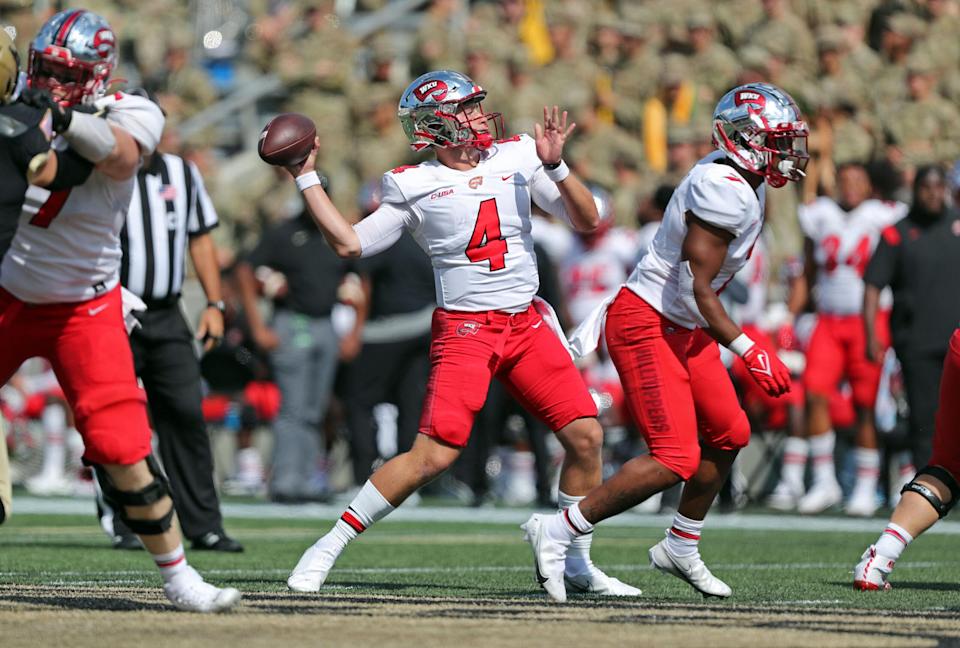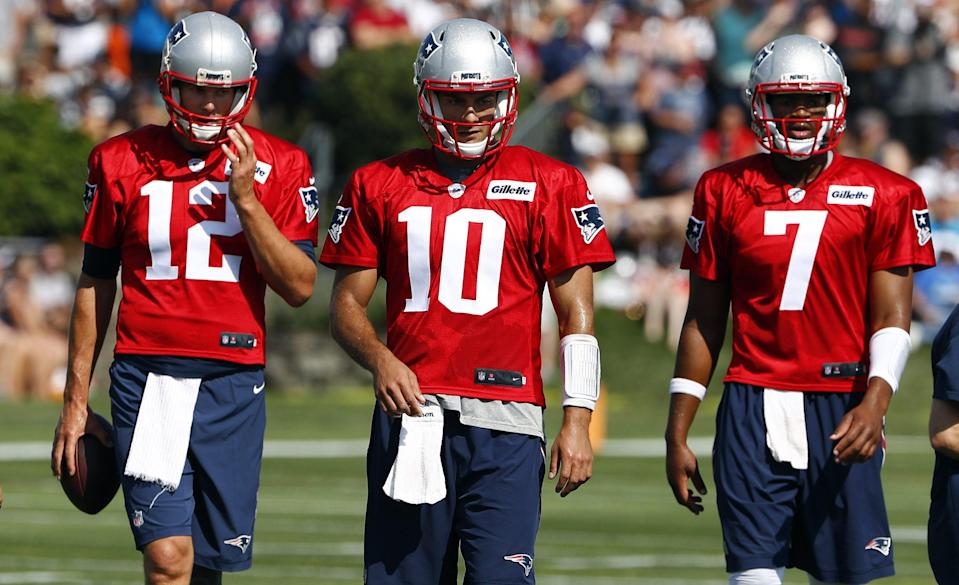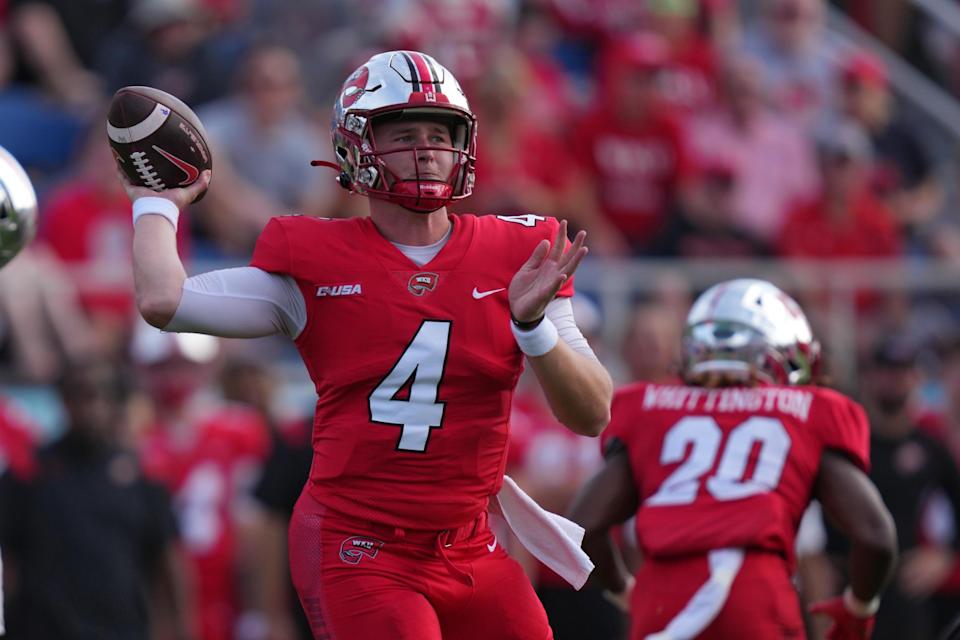
We know absolutely nothing about the NFL draft.
The time for post-mortems is around the corner, and you can believe one of the biggest topics over the next few days will center on how the NFL viewed this incoming quarterback class. After all, after seeing five come off the board within the top-fifteen selections a year ago, we waited until selection 137 in this draft class to hear the fifth quarterback come off the board.
Western Kentucky’s Bailey Zappe, to the New England Patriots.
Heads were scratched in the wake of the move. After all, that meant that Zappe came off the board before Sam Howell and Carson Strong, two passers who generated a lot more early-round buzz than Zappe, despite his prodigious numbers last season for Western Kentucky. Compounding matters was the idea that it was the Patriots who drafted him, as New England was one of those teams who drafted a QB early last year in Mac Jones.
So why Zappe, and why New England?
Drafting quarterbacks is a Belichick staple


(Winslow Townson-USA TODAY Sports)
One of the more fascinating aspects to the Tom Brady/Bill Belichick Era was this. After drafting Brady in the sixth round of the 2000 NFL draft, and seeing him win a Super Bowl during the 2001-2002 season, the Belichick-led Patriots kept adding at the quarterback position.
They added Rohan Davey in the fourth round of the 2002 draft, just months after Brady led them to Super Bowl XXXVI. The following year they drafted Kliff Kingsbury in the sixth round, perhaps putting him on a path to his current coaching job with the Arizona Cardinals. They added Matt Cassell in the seventh round in 2005, and Kevin O’Connell in the third round in 2008 (now the second former quarterback drafted by Belichick to become an NFL head coach).
The next year they added another player in the seventh round who was a college quarterback, although he carved out a role as a wide receiver. That was Julian Edelman.
The next such player drafted by Belichick who might transition from NFL QB to head coach? Zac Robinson, drafted by Belichick in the seventh round of the 2010 draft. After a stint at Pro Football Focus, Robinson is now the passing game coordinator and quarterbacks coach for the Los Angeles Rams.
Starting with the 2011 draft, the Patriots started to address the position earlier and early each time. In 2011 they added Ryan Mallett, who drew some first-round buzz thanks to his size and arm talent. 2014 saw the Patriots draft Jimmy Garoppolo in the second round, another player who was getting first round attention during his draft cycle. In the 2016 draft New England added Jacoby Brissett in the third round, and after adding Danny Etling at the end of the 2018 draft, they selected Jarrett Stidham in the fourth round in 2019.
Counting Edelman, that is 11 quarterbacks drafted while Brady was entrenched as their starter.
Adding at the quarterback position, even with an entrenched starter, is nothing new for Belichick. After the Garoppolo selection in 2014, Belichick was noted as saying “[w]ith the situation we have at quarterback…I think you’re better off being early than late at that position.” He went on to address the decision to add Garoppolo despite having Mallett and Brady still on the roster. “We know what Ryan’s contract situation is,” Belichick said. “We know what Tom’s age and contract situation is. I don’t think you want to have one quarterback on your team. I don’t think that’s responsible to the entire team or the organization.
Currently, the Patriots have Jones as their starter, coming off a rookie season where he helped the organization earn their first playoff berth post-Brady. They also have Brian Hoyer and Stidham in the fold. Still, adding at the position is nothing new for the Patriots, and the organization knows full well the value of improving across the board, even at the backup position. So if this ends with Zappe becoming the backup instead of Stidham, with Hoyer serving as the mentor/veteran option, then the organization will view that as a successful selection.
But…why Zappe over other options?
Why Zappe fits the Patriots’ profile


(Jasen Vinlove-USA TODAY Sports)
In the wake of this move, many wondered why, if the Patriots were going to take a quarterback, Zappe was the selection given other options on the board. By drafting the Western Kentucky product, the Patriots passed on two options who were higher in the minds of media evaluators: Sam Howell and Carson Strong.
I’ll say there are scouts and execs around the league confused by what the Patriots are doing in the draft.
There’s a lot of surprise over NE picking QB Bailey Zappe over Sam Howell.
— Doug Kyed (@DougKyed) April 30, 2022
The selection of Zappe is another window into the Patriots’ evaluation process at the quarterback position. Zappe is an accurate passer, reflected in the charting data available this draft cycle. Pro Football Focus charted Zappe with an Adjusted Completion Percentage of 77.4%, which was tenth among college quarterbacks last season.
For reference, Malik Willis posted an ACP of 70.1%, which ranked 57th. Desmond Ridder’s ACP of 73.9% placed him 33rd among collegiate passers. Kenny Pickett, the sole first-round passer, posted an ACP of 78.8%, ranking him fourth in the class.
Howell? His ACP was 72.4%, good for 45th in the college ranks.
While Howell was perhaps the best deep-ball passer in the class, think of the Patriots offense. This is not a vertical-based system. For years, the Patriots have relied on the horizontal passing game, and that did not change last year with Jones at the helm. Yes, the team will take shots downfield — and their playbook notes that they will call “shot” plays a handful of times each game to stress defenses — but what you do in the short- and intermediate-areas of the field is of paramount importance.
Beyond pure accuracy, Zappe has great feel for the leverage of the nearest defender, and is adept at putting the football in a spot to lead his receivers away from the closest threat, and towards open space, throwing on time and in rhythm. For example, watch the timing on this seam route against Michigan State:
This is a 4th and 7 play in the fourth quarter. Zappe identifies pre-snap that he has a one-on-one matchup to the boundary side of the 3×1 formation, with the cornerback playing inside leverage. He snaps off the throw with anticipation, leading the receiver away from the cornerback’s leverage. The result? Yardage after the catch. As someone who is a firm believer that YAC is in large part a quarterback stat, this is textbook example of that thought. When the ball is out on time and in rhythm, and the throw is placed away from the leverage of the nearest threat, the quarterback puts his receiver in position to gain that yardage after the catch.
The Patriots, for years, have relied on YAC as a foundation of their offense. Zappe fits that profile to a T.
If the Patriots were a more downfield-based attack, Howell was perhaps a better fit. Or even Strong. But for what they do as an offense Zappe is their kind of quarterback.
1
1
